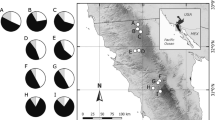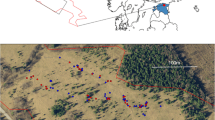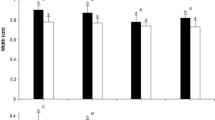Summary
Pre-dispersal seed predators must choose proper hosts and flowers on those hosts that have a high probability of setting seed. In this study, I documented that flowers of Ipomopsis aggregata (Polemoniaceae) chosen by a pre-dispersal seed predator (Anthomyiidae: Hylemya sp.) had a higher probability of seed set than flowers the fly did not choose. I experimentally tested the hypothesis that Hylemya uses a post-fertilization cue in making oviposition choices. I found no evidence for this hypothesis.
Similar content being viewed by others
References
Andersen AN (1988) Insect seed predators may cause far greater losses than they appear to. Oikos 52:337–340
Augsburger CK (1981) Reproductive synchrony of a tropical shrub: experimental studies on effects of pollinators and seed predators on Hybanthus prunifolius (Violaceae). Ecology 62:775–788
Brantjes NBM (1976) Senses involved in the visiting of flowers by Cucullia umbratica (Noctuidae, Lepidoptera). Ent Exp Appl 20:1–7
Brody AK (1992) Oviposition choices by a pre-dispersal seed predator (Hylemya sp.) I. Correspondence with hummingbird pollinators, and the role of plant size, density and floral morphology. Oecologia 91:56–62
Campbell DR (1989) Measurements of selection in a hermaphroditic plant: variation in male and female pollination success. Evolution 43:318–334
Campbell (1991) Effects of floral traits on sequential components of fitness in Ipomopsis aggregata. Am Nat 137:713–737
De Steven D (1983) Reproductive consequences of insect seed predation in Hamamelis virginiana Ecology 64:89–98
Feeny P, Rosenberry L, Carter M (1983) Chemical aspects of oviposition behavior in butterflies. In: Ahmad S (ed) Herbivorous Insects: Host-seeking behavior and mechanisms, Academic Press, New York pp 27–76
Hainsworth FR, Wolf LL, Mercier T (1985) Pollen limitation in a monocarpic species, Ipomopsis aggregata. J Ecol 73:263–270
Janzen DH (1971a) Seed predation by animals. Ann Rev Ecol Syst 2:465–492
Janzen DH (1971b) Cassia grandis L beans and their escape from predators: A study in tropical predator satiation. Ecology 52:964–979
Janzen DH (1976) Why bamboos wait so long to flower. Ann Rev Ecol Syst 7:347–391
Louda SM (1982) Limitations of the recruitment of the shrub Haplopappus squarrosus (Asteraceae) by flower-and seedfeeding insects. J Ecol 68:929–952
Mackay DA, Jones RE (1989) Leaf shape and host-finding behavior of two ovipositing monophagous butterfly species. Ecol Entomol 14:423–431
Moericke V, Prokopy RJ, Berlocher S, Bush GL (1975) Visual stimuli eliciting attraction of Rhagoletis pomonella flies to trees. Entomol Exp Appl 18:497–507
Papaj DR (1986) Conditioning of leaf-shape discrimination by chemical cues in the butterfly, Battus philenor. Anim Behav 34:1281–1288
Pedhazur EJ (1982) Multiple regression in behavioral research. Holt Rinehart and Winston Fort Worth pp 822
Prokopy RJ, Owens ED (1983) Visual detection of plants by herbivorous insects. Ann Rev Entomol 28: 337–364
Rausher MD, Mackay DA, Singer MC (1981) Pre-and post-alighting host discrimination by Euphydryas editha butterflies: the behavioral mechanisms causing clumped distributions of egg clusters. Anim Behav 29:1220–1228
Robertson AI, Giddins R, Smith TJ (1990) Seed predation by insects in tropical mangrove forests: extent and effects on seed viability and the growth of seedlings. Oecologia 83:213–219
Sokal RR, Rohlf FJ (1981) Biometry WH Freeman and Company, San Francisco pp 859
Stanton ML (1979) The role of chemotactile stimuli in the oviposition preferences of Colias butterflies. Oecologia 39:79–91
Straw NA (1989) The timing of oviposition and larval growth by two tephritid fly species in relation to host-plant development Ecol Entomol 14:443–454
Thompson JN (1988) Evolutionary ecology of the relationship between ovipositon preference and performance of offspring in phytophagous insects. Ent Exp Appl 47:3–14
Waser NM (1978) Competition for hummingbird pollination and sequential flowering in two Colorado wildflowers. Ecology 59:934–944
Waser NM, Price MV (1989) Optimal outcrossing in Ipomopsis aggregata: seed set and offspring fitness. Evolution 43:1097–1109
Author information
Authors and Affiliations
Rights and permissions
About this article
Cite this article
Brody, A.K. Oviposition choices by a pre-dispersal seed predator (Hylemya sp.). Oecologia 91, 63–67 (1992). https://doi.org/10.1007/BF00317242
Received:
Accepted:
Issue Date:
DOI: https://doi.org/10.1007/BF00317242




